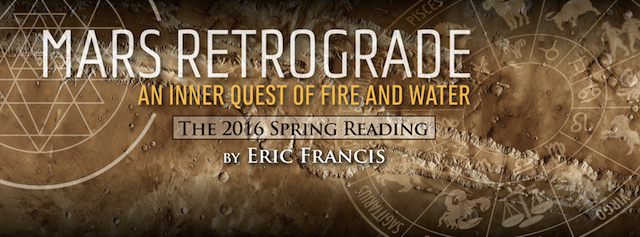Editor’s Note: The following is one of Eric’s classic “clip and save” guides to a particular astrological event — in this case, Mercury retrograde, one of which we’ve just begun. The current Mercury Rx is in Taurus; this piece originally published in the Jan. 24, 2014 members’ issue as a look ahead at that year’s three retrogrades of Mercury, and its wisdom is as valuable as ever. — Amanda P.
Dear Friend and Reader:
Three or four times a year, everyone who knows something about astrology goes through a ritual called Mercury retrograde. Everyone who doesn’t know about astrology gets to have the experience, not sure what it is though perhaps suspecting that something weird is going on.
 |
|
The Path of My Soul. Illustration by Nina Gabriel.
|
We are now approaching the first of four Mercury retrogrades spanning between early February 2014 and early February 2015. The upcoming retrograde begins Feb. 6 with Mercury in Pisces and ends on Feb. 28 with Mercury in Aquarius. What I call the echo phase and what other astrologers call the shadow phase began Jan. 22. The after-retrograde echo phase begins when Mercury stations direct and runs through March 20.
Typically the retrograde itself lasts three weeks, but the whole process — wherein Mercury is dancing around approximately the same 15 degrees of the zodiac, lasts for two months. Hence, while Mercury is retrograde just 19% of the time, the retrograde effect can be felt about half the time. It’s the most concentrated around the days when Mercury changes direction. These are called the stationary points, or stations retrograde and direct.
Associated with lost keys, late or lost payments, disk drive failures and communication mishaps, Mercury retrograde does not have a very good reputation. Yet some people love it — if you’re the creative type, or if you have a slightly tweaky mind, if you like the feeling of swimming against the current, you might be one of the people who looks forward to Mercury retrograde happening. If you’re very sensitive to it for whatever reason, you might take a more cautious approach. Other people seem impervious to it, like it’s not even happening or has no effects. By now you probably know where you stand with this.
Every Mercury retrograde has its own unique pattern, and little clusters of three retrograde events tend to have similar themes as well. Each will influence your personal chart in a distinctive way. In 2014, all of the retrogrades start early in water signs, then track back into air signs. That describes scenarios of having some kind of emotional or aesthetic response (the water sign) that is then understood or analyzed (the air sign).
 |
|
Mind, Body and Soul. Illustration by Nina Gabriel.
|
Thanks to the Internet, more people than ever know about Mercury retrograde. The idea is now lodged in popular consciousness as what’s likely the most familiar technical astrological concept. I just searched Google and got 405,000 results for Mercury retrograde (with the term in quotation marks).
Personally, I didn’t hear about it online. In my first journalism job, I worked for The Echoes-Sentinel, a gritty weekly newspaper in New Jersey. Flo Higgins, my first editor as a professional writer, happened to be an astrologer. She was about 65 years old, with long white hair and a fiery point of view, who had probably read the chart of everyone for 100 miles around.
The paper was part of a newspaper chain, the Recorder Publishing Co. Nobody believed in astrology, but we knew better when it came to Mercury retrograde.
Flo could, and regularly did, terrify the entire company with this one, sending the vibrations throughout the central New Jersey countryside, even getting the stunned attention of nerdy newspaper reporters trained not to believe anything. Nothing ever got into print, of course. The newspapers were too serious for astrology.
Mercury retrograde meant everything was about to go wrong. Flo was so convincing that even Jim, who ran the production facility and could take apart and reassemble a printing press blindfolded, had a paragraph taped to his office door, copied from Debbi Kempton-Smith’s infamous Secret’s From a Stargazer’s Notebook, warning everyone who visited:
Don’t Sign, Don’t Buy: Mercury is Retrograde.
This was my introduction to astrology. That was the first paragraph of an astrology book I ever read. Soon, newcomers to Echoland took it for granted that the Full Moon had something to do with how the mayor was acting, and when the production facility smelled like electrical smoke, it was clearly because Mercury was retrograde.
“Don’t sign, don’t buy” is the usual advice for the retrograde of Mercury. I’ll explain in a moment why that makes sense. It’s also associated with things getting lost, electronic devices going wonky, and being dissatisfied with what you purchase. Communication often comes under strain when Mercury is retrograde. For someone with a scientific or logical mind, the question is: what do all these things have in common?
 |
|
Birds of Paradise. Illustration by Nina Gabriel.
|
Yet there are more humanistic approaches to the topic. “While delays and misunderstandings do seem to happen, I’ve noticed a magical trend — that people and ideas return, for integration, resolution and more,” writes Molly Hall on About.com.
People returning to our lives out of the mists of time is one potential effect of any inner planet retrograde, one of their more mysterious qualities.
But what is this event really about? And how might it work?
Let’s start with Mercury, the planet. This fleeting little world, the one closest to the Sun, is associated with the mind, with ideas and with communication. Mercury is the messenger of the gods, and also the trickster. It’s associated with, as in it’s the traditional ruler of, Gemini and Virgo, two mutable signs (mentally oriented, flexible, a bit nervous). Both of those signs have signs opposite them that are ruled by Jupiter (Sagittarius and Pisces).
In modern astrology, Mercury picks up many of its ancient associations — for example, the messenger function translates to mail and telegraph. It’s associated with communication of all kinds, communication devices, computing devices, commerce and the flow of money (rather than acquiring wealth — that seems to be more about Mars). Surrounded as we are by all of these devices, and nonstop messaging, and by financial instruments (such as debit cards) that are morphed with communication devices (such as the World Wide Web), we have given Mercury a lot of power in our lives.
Hence, Mercury retrograde is probably more powerful in our lives than it ever was. We swim in an ocean of things ruled by Mercury. Our consciousness is fully immersed in them; in many ways so is our identity. With the advent of handheld devices that go on the Internet, this seems to transcend economic barriers now more than ever.
In English the word mercurial means “sprightly, volatile, quick,” associated with the speed with which the planet Mercury moves, and how fast and how frequently it seems to change directions (that is the retrograde). It can have a sharp wit and seem smarter than you — Bob Dylan has been described as mercurial and he’s also a Gemini, one sign that Mercury rules.
 |
|
Fire & Water. Illustration by Nina Gabriel.
|
Mercury is the Roman incarnation of the Greek god Hermes, and these figures show up throughout Western mythology.
In Norse mythology, he gets the role as presiding officer of the gods rather than as messenger — though of course that supposed role as messenger is a disguise for a much more significant function.
In Egyptian mythology he is the mighty Thoth, who was nobody’s messenger, or fool; he was responsible for the development of writing and science, maintaining the state of the universe and assisting with the judgment of the dead. Picking up on the ambivalence theme, Thoth was a mediator between good and evil, making sure that neither had a decisive victory in an ongoing struggle that continues to this day.
There’s also an association to the element mercury, or quicksilver, the only metal that is a liquid at room temperature. Mercury’s androgynous and liquid quality hints at a certain ambivalence. The old astrology books describe the planet’s nature as neither male nor female. Between metrosexuality and the LGBTQ movement, we have some clues that gender roles and relationships are coming under the increasing influence of Mercury.
It’s interesting that mercury the metal is a persistent environmental contaminant, and one that is known to interact with and disrupt the normal action of sex hormones. The element mercury is known to artificially induce androgyny.
Iron, Not Quicksilver: From Astronomy to Psychology
Mercury retrograde happens when the planet Mercury passes between the Earth and the Sun. Because Mercury’s orbit is about 84 days, this happens three times a year. While the retrogrades typically last about 22 days, there is a margin on either side of two to three weeks where the influences can be felt.
Mercury is not made of mercury. It has a huge core with a very high density, leading astronomers to believe that it’s made mostly of iron. In fact Mercury is believed to have the highest iron content of any planet in the Solar System.
 |
|
Over the Rainbow. Illustration by Nina Gabriel.
|
This is all another way of saying Mercury retrograde means a huge magnet passes between the Earth and the Sun, making its closest pass to our planet at the same time. This may explain why devices act weird, but I think that it also helps explain why the mind gets wonky, such as the tendency to lose things, or to perceive problems as being worse than they are — the nervous system runs on electricity. The mind is a device that is, at least on the physical plane, rooted in electricity and magnetism.
In my view, the effects of the retrograde are evenly distributed between a perceptual event and one in the world outside the mind. The combined interaction is powerful, the more so for not being easily discernible as a reality or as an effect of the mind. A purely mental phenomenon seems to be associated with a Mercury retrograde effect, so notice how your mind is handling problems or puzzles when they arrive. I have observed that the approach to a problem really does suggest whether and how that problem will be solved.
With the space remaining I will pass along, in summary form, some of what I have learned about Mercury retrograde. I don’t mean what I have learned from books — I mean what I have observed tracking, experimenting with and doing consulting about every Mercury retrograde since 1994, and some going back to 1987.
I agree with “don’t sign, don’t buy.” That is, when you can avoid doing so. I have experimented with making purchases during or near Mercury retrogrades. Most of the time it turns out I don’t need or don’t use what I purchased. Sometimes it does not work, works strangely or does not do what I intended it to do. So I divide my life into times when I buy things and times when I
don’t.
I will usually (as in 99% of the time) make major purchases only with Mercury direct and out of echo phase. There are rare exceptions, but not so many. If you buy something during a retrograde, try not to be too attached to it, or expect a break-in period, while you work out the bugs. Sometimes things work out just fine. Really, most things can wait a week or two or three. If they cannot wait, be extra conscious of all the factors involved in the sale, don’t rush the process, keep your paperwork and make sure there is a good return policy. Choose carefully and get a good one, whatever it is.
 |
|
The Way of Mother Nature. Illustration by Nina Gabriel.
|
As for contracts, it’s not always possible to determine when you sign your lease or make the deposit, but I have been known to make landlords wait for weeks before even leaving a deposit. (Hi Stefan!)
Plan ahead and use what flexibility you have. It’s worth finagling this to your advantage when you can. The operative events are the first payment and the signature on the contract.
The problem if you sign with Mercury retrograde, or about to retrograde, is that something is likely to reverse itself — an elementary illustration of what it could mean that Mercury changes directions. Or, you will learn something you wish you had known sooner. Which leads to my second point.
There are legitimate questions of what to do when you have a house closing scheduled for during Mercury retrograde, if you have to start a new job, or you get the bug to have that new car. I plan to write more about this; there are some basic approaches that can be applied, one of which is to understand exactly what is in the contract or commitment and not make any promise that you cannot keep.
If the situation involves significant amounts of money, a real commitment or the potential for a real inconvenience, it might be a good idea to talk to an astrologer who truly knows what they are doing with Mercury retrograde. [I can usually handle this kind of consultation in-and-out much of the year.]
The truth comes out when Mercury stations, either retrograde or direct. Mercury has a way of shaking out information, especially right as it stations. You can count on this. If you’re working on a mystery, or a riddle, or an investigation, or research, or trying to solve any mental puzzle, keep it going till the next Mercury station retrograde. Just to be sure, wait for the second batch of information just as Mercury stations direct. This is one reason you want to wait before signing or buying.
If an item of communication is missed, don’t assume you’re being ignored. Many people shoot off one email and expect a reply. With spam filters, busy people processing hundreds of emails a day and odd errors like emails not arriving, it’s better to give people the benefit of the doubt. Give people a day or two to respond, and if they don’t, send over a friendly one-liner to the effect of, “Hey I emailed you, just want to make sure you saw it.”
 |
|
The Music of My Soul. Illustration by Nina Gabriel.
|
If communication gets dicey, pick up the phone. We are getting better at communicating online, but still, it can be difficult to relay feelings or basic concepts, especially with Mercury retrograde. The moment things get weird, such as if there is a misunderstanding, pick up the phone and clarify — before things get out of control or real misunderstandings happen. It’s better not to conduct arguments by email. It has all the sensitivity of sniper fire. Err on the side of being human.
Resolve the past, plan the future. I have found that the best use for Mercury retrograde is to tidy up what you’ve left unresolved in the past. Clean your desk, organize your stuff, contact old friends, go through your email and see if you missed anything important. While you’re at it, collect your ideas and figure out what you’re going to do next. Plot and scheme. Use the various qualities of the retrograde to refine your plan over time, then plan a launch sometime after the station direct.
If it may not be broke — don’t fix it so fast. One phenomenon I’ve noticed during Mercury retrograde is that things seem broken or like they are malfunctioning but are not really. Or, the problem is one thing but you think it’s another. Or, the problem is not as bad as you think. Therefore, before tearing everything apart, or spending a lot of money, or sending anything back to the factory, troubleshoot carefully and try simple solutions. Break out pure logic and apply that as a tool. Look for temporary workarounds and see if the issue resolves on its own. I’m suggesting you avoid solving a problem that doesn’t exist, or worse, making a bigger problem than you thought you had.
Always remember that Mercury is the trickster.
That means he, she or it can be tricky, and you need to use your mind — not have your mind be tricked. Mercury is a kind of a game. Be a good sportsman and keep your sense of humor.
Lovingly,

About the Artist: Nina Gabriel is an artist, poet and writer working from her home-based studio in Los Angeles, CA. She says: “To produce art is the most satisfying experience for me and the results of my work I would like to share with as many people as possible thus spreading my spirit far and wide. It is my sincere wish that my art and poetry bring peace, happiness and joy to anyone that appreciates it. I also hope that it will bring forth many positive feelings such as love, faith, confidence and truly all the good that life has to offer.” Visit her blog here.
Click here to read the complete edition this piece came from.
















